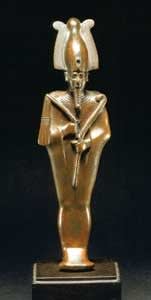26th Dynasty Egyptian Bronze Sculpture of Osiris, 664 BCE - 525 BCE
Bronze
6.25
X.0340
This elegantly modeled statuette represents Osiris, the ancient Egyptian god of eternity. He is depicted in his traditional raiment which consists of a tightly-fitting, form-revealing shroud from beneath which the...
This elegantly modeled statuette represents Osiris, the ancient Egyptian god of eternity. He is depicted in his traditional raiment which consists of a tightly-fitting, form-revealing shroud from beneath which the taut, physically-fit forms of his ankles, calves, knees, thighs, elbows, and biceps appear. The shroud is designed with two flared openings for his hands, the projecting fists of which hold the crook and flail. These are the traditional attributes of this god which inextricably link him with his remote, agricultural origins. The crook symbolizes shepherds and herdsmen and the flail farmers of grain with which it was anciently threshed. The cyclic nature of the plant and animal kingdoms served as metaphors for resurrection, and these reminded the ancient Egyptians of the key role Osiris played in their funerary beliefs.
The god wears as accessories a broad collar indicated by a series of incised, concentric circles, the lower one ornamented with stylized beads as well as a plaited, curved false beard. His headdress is the atef consisting of the White Crown of Upper Egypt flanked on each side by an ostrich feather and fronted by a uraeus, or sacred cobra.
Ancient Egyptian art at its finest is characterized by the integration of line and plane in the design of statuary. Our statuette of Osiris is an outstanding example of this aesthetic. The figure is modeled in broad, simplified planes which imbue our Osiris with an eloquent majesty. That feeling is enhanced by the sagacious use of linear adjuncts which indicate the broad collar, the segmented elements of both the crook and flail, the braiding inherent in the false beard, and the ribbing of the ostrich feathers. This elegance is further enhanced by the proportions of the slender, attenuated figure, the verticality of which is accentuated by the long staff of the crook.
As a result of this aesthetic, our elegant statuette can be dated to the Saite Period, when the ancient Egyptian canon of proportions was transformed, perhaps in response to influences from the Greek world. (X.0340)
References:
K. Bosse, Die Menschliche Figur (Glückstadt 1936), page 36, no. 80, the bronze statuette of Khonsu-ir-di-su [London, The British Museum 14466], dated to Dynasty XXVI by inscription, which exhibits these same, progressive attenuated features; and G. Roeder, Ägyptische Bronzefiguren (Berlin 1956), plate 22, figures e-h, for other bronze figures of Osiris with similarly designed, long staved flails, and plate 23, figures a-c, for an example, the quality of which approaches that of our Osiris.
The god wears as accessories a broad collar indicated by a series of incised, concentric circles, the lower one ornamented with stylized beads as well as a plaited, curved false beard. His headdress is the atef consisting of the White Crown of Upper Egypt flanked on each side by an ostrich feather and fronted by a uraeus, or sacred cobra.
Ancient Egyptian art at its finest is characterized by the integration of line and plane in the design of statuary. Our statuette of Osiris is an outstanding example of this aesthetic. The figure is modeled in broad, simplified planes which imbue our Osiris with an eloquent majesty. That feeling is enhanced by the sagacious use of linear adjuncts which indicate the broad collar, the segmented elements of both the crook and flail, the braiding inherent in the false beard, and the ribbing of the ostrich feathers. This elegance is further enhanced by the proportions of the slender, attenuated figure, the verticality of which is accentuated by the long staff of the crook.
As a result of this aesthetic, our elegant statuette can be dated to the Saite Period, when the ancient Egyptian canon of proportions was transformed, perhaps in response to influences from the Greek world. (X.0340)
References:
K. Bosse, Die Menschliche Figur (Glückstadt 1936), page 36, no. 80, the bronze statuette of Khonsu-ir-di-su [London, The British Museum 14466], dated to Dynasty XXVI by inscription, which exhibits these same, progressive attenuated features; and G. Roeder, Ägyptische Bronzefiguren (Berlin 1956), plate 22, figures e-h, for other bronze figures of Osiris with similarly designed, long staved flails, and plate 23, figures a-c, for an example, the quality of which approaches that of our Osiris.
